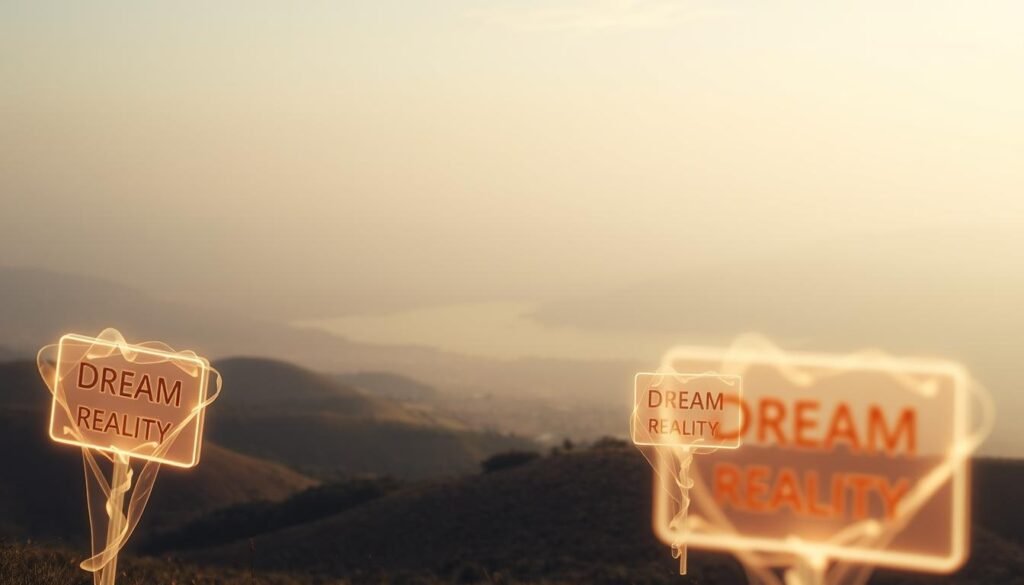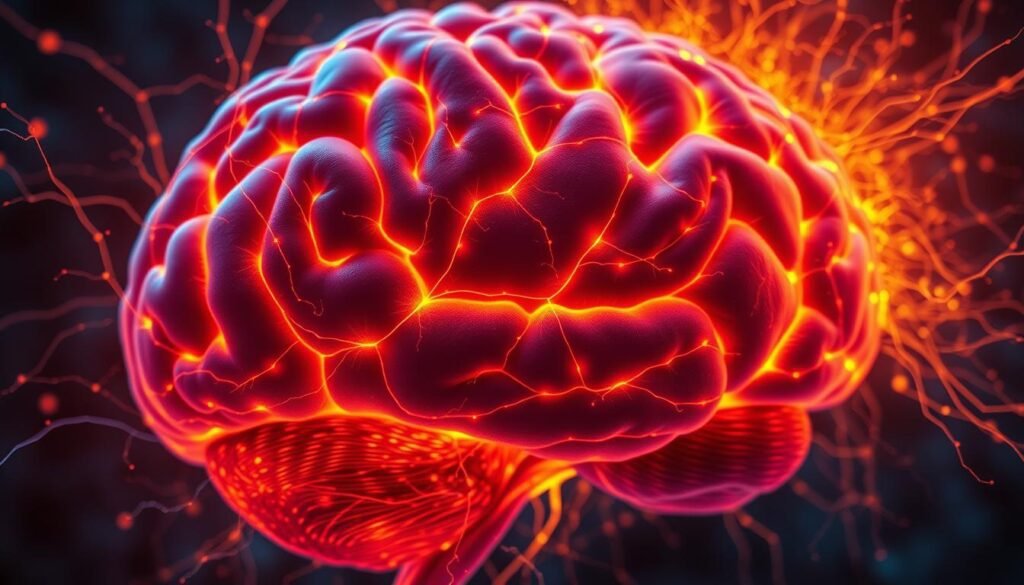Ever stopped and thought, “Is this real or just a dream?” Wondering if we’re awake or dreaming is more than a brain teaser. It’s a deep dive into how we think and feel.
Dream-reality confusion is a real issue in psychology. It makes us question if we’re awake or asleep. This blurs the lines between our different states of mind.
Our brains are amazing at creating real-like dreams. These dreams can feel so real, it’s hard to tell if we’re dreaming or not. This article will look into the science, philosophy, and psychology behind dreams and reality.
We’ll learn how to tell if we’re dreaming. We’ll also explore why we often doubt reality. You’ll discover the world of dreams and how we see things.
Get ready to rethink what’s real and what’s not. You’ll learn about the cool ways our brains work and how we see the world.
Understanding Dreams and Reality
Dreams are a fascinating part of our minds, mixing up what we see and what we imagine. They give us a peek into our subconscious, showing us complex thoughts that question our view of reality.

To explore dreams, we need to look into their basic traits and what they mean to us.
The Mysterious Nature of Dreams
Dreams happen during certain sleep stages, creating vivid scenes that can feel very real. Scientists have found several important things about how dreams are made:
- Neurological processes triggered during REM sleep
- Subconscious emotional processing
- Memory consolidation mechanisms
“Dreams are the touchstone of our unconscious mind.” – Sigmund Freud
Common Dream Characteristics
Dreams have special features that make them different from waking life:
- Nonlinear narrative structures
- Distorted spatial and temporal perceptions
- Heightened emotional intensity
- Surreal or impossible scenarios
Perception and Dream Influence
Dreams deeply affect our minds, shaping our feelings and how we think. They help us deal with tough mental experiences.
Learning about dreams helps us understand our minds better. It shows how our subconscious thoughts connect to our waking lives.
Signs You Might Be Dreaming
Dreams mix reality with imagination, creating strange scenarios. It’s hard to tell when you’re dreaming. But, some signs show that you’re in a dream world.

Inconsistent Logic in Events
Dreams have their own rules, unlike the real world. You might fly without wings or fall endlessly. Places change, with windows where walls should be.
Time also gets mixed up. A day can feel like just a few minutes.
- Encountering dead relatives as if they’re alive
- Enemies suddenly acting like best friends
- Strangers appearing in recognizable settings
- Reliable mechanical devices unexpectedly failing
Unusual Sensations and Feelings
Dreams bring intense feelings and sensations. You might feel paralyzed or see things unclearly. Losing body parts, like teeth, is common.
- Being naked in public
- Having monsters or dangerous creatures chase you
- Experiencing heightened emotional states
- Feeling trapped in a “toilet dream” where you think you’re awake
Knowing these signs can help you tell dreams from reality. It’s a way to understand your subconscious mind.
Techniques to Differentiate Reality from Dreams
It can be hard to tell dreams from reality. Reality testing helps you understand the difference. It makes you more aware of your surroundings.

Reality checks are exercises to see if you’re dreaming or awake. They make your brain notice small details that show you’re dreaming.
Essential Reality Check Methods
- Mirror checking: Look at yourself in a mirror. See if your reflection looks normal. Dream reflections often look odd.
- Observing the time: Check clocks or digital displays. Dreams often show strange or changing times.
- Hand examination: Look at your hands carefully. Dream hands might have extra fingers or seem blurry.
- Solid object test: Try to push your hand through a solid object. In a dream, you might pass through like a ghost.
- Rubber band method: Wear a rubber band and check if it’s on your wrist. Dreams can change how you feel things.
Developing Metacognitive Awareness
Reality testing trains your mind to notice your own awareness. It’s like a mental workout. By doing these checks often, you get better at noticing when you’re dreaming.
Consistent practice is key to developing dream awareness and distinguishing between dream states and wakefulness.
Experts say to pick one reality check and do it often. This trains your brain to spot the difference between dreams and being awake.
The Role of Lucid Dreaming
Lucid dreaming lets us explore our minds while we sleep. It’s a special state where we know we’re dreaming but still feel like we’re in the dream. This is a unique way to see our subconscious.
Experts have come up with many ways to start lucid dreaming. Each method has its own way of helping us become aware in our dreams:
Understanding Lucid Dream Induction
There are several ways to trigger lucid dreaming:
- Wake-initiated lucid dreaming (WILD) lets dreamers jump right into a dream from being awake
- Wake back to bed (WBTB) means setting an alarm 5 hours after bedtime, then staying awake for 30 minutes before sleeping again
- Mnemonic Induction of Lucid Dreams (MILD), created by Stephen LaBerge in 1980, helps by setting an intention to remember you’re dreaming
“The dream is a little hidden door in the innermost and most secret recesses of the soul.” – Carl Jung
Effective Lucid Dreaming Strategies
Studies show the best way is to mix different techniques. People often use reality testing, WBTB, and MILD together to get into lucid dream states.
To successfully start lucid dreaming, you need to practice, be patient, and stick to a routine. By becoming more aware and using specific techniques, you can tap into the amazing world of conscious dreaming.
Philosophical Perspectives on Reality
For centuries, philosophers have grappled with the nature of reality. They debate what is real versus what might be an illusion. This debate touches on consciousness and experience.

Philosophers have come up with interesting theories. They question the line between dreams and being awake. They challenge our basic views on perception and consciousness.
René Descartes’ Dream Argument
René Descartes introduced a key idea that shook our understanding of reality. His Dream Argument suggested our senses might just be dreaming.
“How can I be certain that this moment is real and not simply a vivid dream?” – René Descartes
- Questioned the reliability of sensory perception
- Suggested our experiences might be systematically deceptive
- Challenged traditional assumptions about reality
Contemporary Philosophical Interpretations
Today’s philosophers have built on Descartes’ ideas. They dive into complex questions about consciousness, perception, and reality. They use many different fields to explore these topics.
- Investigating neurological foundations of perception
- Examining cognitive processes that construct our reality
- Analyzing the relationship between subjective experience and objective world
These ongoing philosophical studies are expanding our knowledge. They show how complex human consciousness is.
The Science Behind Dreaming
Dreams are a fascinating part of our brains that scientists love to study. They help us understand our minds and how they work when we sleep.

Sleep Cycles and Neurological Patterns
Our brains go through different sleep cycles at night. Each cycle has its own unique patterns. People go through several stages during sleep:
- Non-Rapid Eye Movement (NREM) stages
- Rapid Eye Movement (REM) sleep
- Transitional microsleep periods
REM sleep is when dreams are the most vivid. It’s like being awake, with lots of brain activity and memory work.
Neuroscientific Explanations of Dreaming
There are many theories on why we dream:
- Memory Processing: Dreams might help us remember and organize important stuff
- Emotional Regulation: Dreams could help us deal with our feelings
- Cognitive Simulation: Dreams might be like mental practice for real life
Dreams give us a peek into how our brains work when we’re not awake.
Today, scientists are learning more about sleep, dreams, and how our brains work. It’s really interesting to see what they find out.
Psychological Interpretations of Dreams
Dreams have always been a mystery to psychologists. They see dreams as a way to peek into our subconscious. Different theories try to make sense of our nighttime adventures. These theories help us understand our inner world.
Studying dreams has been key in psychology. It shows how our sleep and waking lives are connected. Various views offer different ways to grasp these enigmatic mental journeys.
Sigmund Freud’s Dream Theories
Sigmund Freud changed how we see dreams. His main ideas include:
- Dreams as royal road to the unconscious
- Symbolic representation of hidden desires
- Unconscious wish fulfillment mechanism
- Psychological defense against repressed emotions
Contemporary Psychological Perspectives
Today’s psychologists have built on Freud’s work. They’ve come up with more detailed ways to understand dreams:
- Cognitive processing of daily experiences
- Emotional regulation through dream states
- Neurological memory consolidation
- Psychological problem-solving mechanisms
Research now shows dreams have many roles. They help us process emotions and integrate our experiences.
“Dreams are the touchstone of our character.” – Henry David Thoreau
The Impact of Dreams on Daily Life
Dreams are more than just nighttime mysteries. They are powerful tools that help us think creatively and solve problems. Scientists have studied how our subconscious mind works during sleep. They found that it unlocks new ideas and insights.
Unlocking Creative Potential through Dreams
Many big discoveries started in dreams. Creative people often find unique solutions in their sleep. Artists, scientists, and business leaders say dreams inspire them with new ideas.
- Salvador Dali developed surrealist paintings inspired by dream imagery
- Paul McCartney composed the melody for “Yesterday” in a dream
- Einstein’s theory of relativity emerged from dream-like thought experiments
Dreams as Problem-Solving Platforms
Our brain keeps working on tough problems while we sleep. Unconscious problem-solving makes connections that our awake minds might not see. Scientists believe dreams help create new ways of thinking.
Dreams are the playground where our brain experiments with impossible solutions.
Learning about dreams can help us use our brain’s creative power. By paying attention to our dreams and keeping a dream journal, we can unlock our brain’s problem-solving abilities.
Cultural Perspectives on Dreams
Dreams have always fascinated people worldwide. They are seen as messages, spiritual experiences, and a peek into our subconscious. This has been true for centuries.
Over time, cultures have found their own ways to understand dreams. These views show how deeply dreams matter to us.
Sacred Visions in Ancient Cultures
In ancient times, dreams were seen as a way to talk to gods. Each culture had its own way of seeing dreams:
- Egyptians thought dreams were messages from gods.
- Native American tribes believed dreams offered spiritual guidance.
- Mesopotamians saw dreams as a way to communicate with spirits.
“Dreams are the touchstone of our character.” – Henry David Thoreau
Contemporary Dream Beliefs
Today, we see dreams in a new light. We mix science and psychology to understand them. Now, we look at dreams in many ways:
- We analyze them as a way to understand our unconscious.
- Science studies our brain when we dream.
- We also see dreams as symbols with personal meanings.
Today, research is still trying to understand dreams. It connects science with cultural views.
Understanding Consciousness
Consciousness is a fascinating and complex part of human experience. Our view of reality changes in different states. This makes us question how we see and understand the world.
The human mind goes through many layers of awareness. This creates a complex world of mental experiences. These experiences go beyond just being awake or asleep.
Exploring Different States of Consciousness
Our consciousness exists in various states:
- Normal waking consciousness
- Sleep and dream states
- Meditative awareness
- Altered states through meditation or contemplation
- Unconscious cognitive processing
The Uncertainty of Wakefulness
It’s hard to know where reality ends and perception starts. Neurological research shows our waking experience might be more changeable than we thought.
Our perception of reality is a constructed experience, not an absolute truth.
Neuroscientists found that our brain always makes sense of what we see and hear. This means our view of “reality” can change more easily than we think.
- Brain creates perceptual models
- Sensory information gets filtered
- Cognitive biases influence perception
Learning about these complex states of consciousness helps us see how complex our perception is. It shows how our mind builds our experience of reality.
Practical Applications of Understanding Dreams
Dreams are more than just something we dream at night. They can help us grow and feel better mentally. Dreams let us peek into our subconscious, showing us our feelings, desires, and challenges we haven’t faced yet.
Looking into dreams can lead to big discoveries about ourselves. By studying our dreams, we can learn more about ourselves, find patterns in our thoughts, and find ways to overcome obstacles. Studies at Stanford University show that understanding dreams can help us understand our emotions better.
Enhancing Self-Awareness
Exploring dreams can help us know ourselves better. We can spot common themes, what makes us upset, and what we think but don’t say. Experts say keeping a dream journal is key to understanding ourselves better.
This journal can show us what we’re struggling with, how we relate to others, and where we can improve. It’s a powerful tool for personal growth.
Improving Sleep Quality
Getting to know our dreams can also make us sleep better. Keeping a dream journal, relaxing before bed, and using strategies to change our thoughts can help us sleep better. This way, we can feel calmer at night and have more fulfilling sleep.

